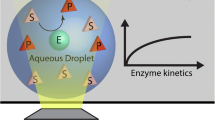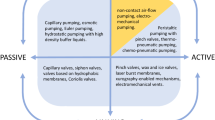Abstract
Stopped-flow technology is frequently used to monitor rapid (bio)chemical reactions with high temporal resolution, e.g., in dynamic investigations of enzyme reactions, protein interactions, or molecular transport mechanisms. However, conventional stopped-flow devices are often overly complex, voluminous, or costly. Moreover, excessive amounts of sample are often wasted owing to inefficient designs. To address these shortcomings, we propose a stopped-flow system based on microfluidic design principles. Our simple and cost-efficient approach offers distinct advantages over existing technology. In particular, the use of injection-molded disposable microfluidic chips minimizes required sample volumes and associated costs, simplifies handling, and prevents adverse cross-contamination effects. The cost of the system developed is reduced by an order of magnitude compared with the cost of commercial systems. The system contains a high-precision valve system for fluid control and features automated data acquisition capability with high temporal resolution. Analyses with two well-established reaction kinetics yielded a dead time of approximately 8-9 ms.







Similar content being viewed by others
Notes
A PMMA 7 N layer of 2 mm blocks approximately 50% of the light at 280 nm. The optical path through the chip material has a length of 1 mm before plus 1 mm after the detection cell.
The reaction was set up following a protocol described in [19] for the labeling of alanine.
References
Chance B (1940) J Franklin Inst 229:455–613
Gibson QH, Milnes L (1964) Biochem J 91:161
Sykora J, Meyer-Almes FJ (2010) Biochemistry 49(7):1418–1424
Gabibov AG, Kochetkov SN, Sashchenko LP, Smirnov IV, Timofeev VP, Severin ES (1983) Eur J Biochem 132(2):339–344
Biro FN, Zhai J, Doucette CW, Hingorani MM (2010) J Vis Exp (37):1874, doi:10.3791/1874
Kern S, Riester D, Hildmann C, Schwienhorst A, Meyer-Almes FJ (2007) FEBS J 274(14):3578–3588
Nienhaus U (2005) Protein-ligand interactions – methods and applications. Humana, Totowa
Tonomura B, Nakatani H, Ohnishi M, Yamaguchi-Ito J, Hiromi K (1978) Anal Biochem 84:370–383
Peterman BF (1979) Anal Biochem 93:442–444
Guo M, Bhaskar B, Li H, Barrows TL, Poulos TL (2004) Proc Natl Acad Sci USA 101(16):5940–5945
van Dael H (2003) Protein Sci 12:609–619
Zhang HJ, Sheng XR, Niu WD, Pan XM, Zhou JM (1998) J Biol Chem 273:7448–7456
Stumps MR, Gloss LM (2008) J Mol Biol 384:1369–1383
Engel MFM, van Mierlo CPM, Visser AJWG (2002) J Biol Chem 277:10922–10930
BioLogic (2010) Bio-Logic - rapid-mixing instruments. http://www.bio-logic.info/rapid-kinetics/rmi.html. Accessed 14 Sep 2010
TgK Scientific (2010) High-pressure stopped-flow. http://www.hi-techsci.com/products/highpressure. Accessed 14 Sep 2010
Kobayashi K, Yoshioka S, Kato Y, Asano Y, Aono S (2005) J Biol Chem 280:5486–5490
Fan YX, Zhou JM, Kihara H, Tsou CL (1998) Protein Sci 7:2631–2641
Stein S, Böhlen P, Udenfriend S (1974) Arch Biochem Biophys 163:400–403
Brown L, Koerner T, Horton JH, Oleschuk RD (2006) Lab Chip 6:66–73
Hardt S, Drese KS, Hessel V, Schönfeld F (2005) Microfluid Nanofluid 1:108–118
Green J, Holdo AE, Khan A (2007) Int J Multiphys 1(1):1–32
Nguyen NT, Wu Z (2005) J Micromech Microeng 15:R1–R16
Hessel V, Löwe H, Schönfeld F (2005) Chem Eng Sci 60:2479–2501
Falk L, Commenge JM (2010) Chem Eng Sci 65:405–411
Berger RL, Balko B, Chapman HF (1968) Rev Sci Instrum 39:493–498
Mansur EA, Mingxing YE, Yundong W, Youyuan D (2008) Chin J Chem Eng 16(4):503–516
Bothe D, Stemich C, Warnecke HJ (2006) Chem Eng Sci 61:2950–2958
Reynisson E, Josefsen MH, Krause M, Hoorfar J (2006) J Microbiol Methods 66(2):206–216
Author information
Authors and Affiliations
Corresponding author
Rights and permissions
About this article
Cite this article
Bleul, R., Ritzi-Lehnert, M., Höth, J. et al. Compact, cost-efficient microfluidics-based stopped-flow device. Anal Bioanal Chem 399, 1117–1125 (2011). https://doi.org/10.1007/s00216-010-4446-5
Received:
Revised:
Accepted:
Published:
Issue Date:
DOI: https://doi.org/10.1007/s00216-010-4446-5




